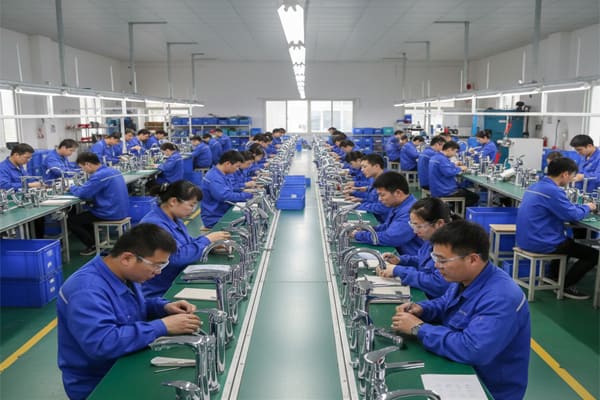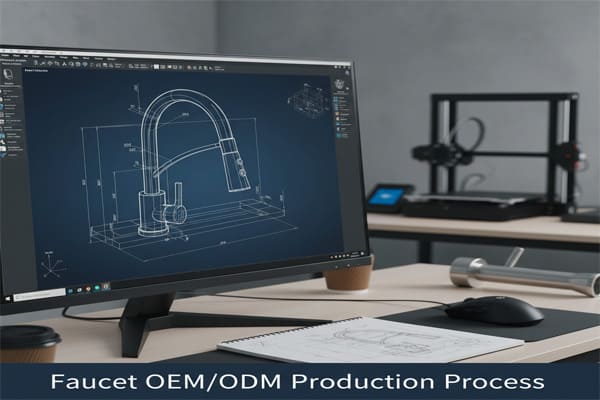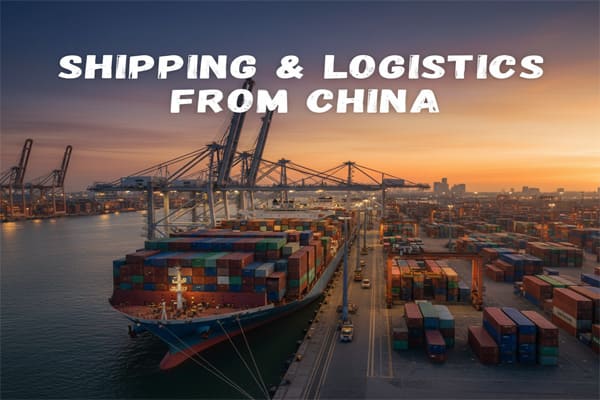Struggling to source sanitary materials from China? You worry about quality, communication, and delays. A clear, proven process is the key to successfully importing without the usual headaches.
The best way to import sanitary materials is to find a reliable OEM/ODM manufacturer1, manage the production process2 closely, and coordinate logistics. For faucets, this means partnering with a factory like SpringFaucet, which handles everything from design to shipping, ensuring quality and a smooth experience.

Importing from China can seem like a huge task, but it doesn't have to be. I've spent years navigating this process, and I've learned that breaking it down into manageable steps is the secret. It all starts with finding the right partner who understands your market and your needs. Once you have that foundation, the rest of the puzzle pieces fall into place much more easily. Let's walk through the exact steps I take to ensure every shipment is a success.
How Do You Find a Reliable Faucet Supplier in China?
Finding a trustworthy supplier feels like searching for a needle in a haystack. You send out dozens of inquiries, but you're never sure who you can really trust.
To find a reliable faucet supplier3, look for manufacturers with proven export experience, strong OEM/ODM capabilities, and international certifications4. A factory with over 18 years of experience, like SpringFaucet, demonstrates stability and a deep understanding of global quality standards5, making them a safe choice.
<sup id=](https://springfaucet.com/wp-content/uploads/2025/11/faucet-supplier.jpg)
When I first started sourcing faucets, my main focus was on price. I quickly learned that was a mistake. A low price often means corners are cut on materials, quality control, or even basic communication. The real value is in a partner who prevents problems before they happen. A reliable supplier isn't just a vendor; they are an extension of your team. They should understand your brand's needs and be committed to meeting them. This means looking beyond the price tag and evaluating their entire operation.
Key Factors for Vetting Suppliers
The most important part of the process is your due diligence. You need to verify that the supplier can deliver what they promise. I focus on a few key areas to make my decision.
| Vetting Criteria | What to Look For | Why It Matters |
|---|---|---|
| Experience | 15+ years in export, specifically to your market (e.g., Europe, "Belt and Road" countries). | They understand your region's quality standards5, compliance needs (like CE, WRAS, ACS), and business culture. |
| Services | Full OEM/ODM capabilities, from design and CAD to final production. | This ensures they can create a unique product for your brand, not just sell a generic item. |
| Quality Control | A clear quality control process6, including raw material checks, in-process inspections, and final testing. | This reduces your risk of receiving defective products, which saves you money on returns and protects your brand's reputation. |
| Communication | Fluent English-speaking sales and technical teams. Responsive and clear communication. | Misunderstandings can lead to major production errors. Clear communication is essential for a smooth project. |
Finding a partner who checks all these boxes, like SpringFaucet, simplifies the entire import process. You can trust them to manage the details, allowing you to focus on growing your business.
What Does the Faucet Production Process Look Like?
You've approved a design, but now you're worried. Will the final product match the sample? A transparent production process2 is the only way to ensure your vision becomes a reality.
A typical OEM/ODM faucet production process2 includes design consultation, CAD drawings, mold creation, sample production for approval, and finally, mass production7 with strict quality control at every stage. This step-by-step approach guarantees the final product meets your exact specifications and quality standards5.

I remember one of my first custom orders. I was so nervous that the factory would misunderstand my requirements. But a good manufacturing partner walks you through each step, asking for your approval along the way. This collaborative approach removes the guesswork and gives you confidence. The goal is to catch any potential issues during the design or sampling phase, not when you have a container full of products. A structured process isn't just about making a faucet; it's about building a product that perfectly represents your brand.
From Idea to Reality: The OEM/ODM Journey
The OEM/ODM process turns your concept into a market-ready product. It's a journey with several critical milestones. At SpringFaucet, we've refined this process over 18 years to be as efficient and transparent as possible for our clients.
Here are the key stages:
-
Product Concept & Design: It all starts with your idea. We work with you to understand your market needs, desired features, and target price point. We can work from your designs or help you create something new.
-
CAD Drawing & Prototyping: Our engineers translate the design into detailed CAD drawings. This technical blueprint ensures every dimension and curve is precise. Once you approve the drawings, we can create a prototype or 3D model.
-
Mold Creation: This is a crucial step for mass production7. We create high-precision molds based on the approved CAD designs. The quality of the mold directly impacts the quality and consistency of the final product.
-
Sample Production & Approval: Before starting mass production7, we produce a small batch of samples. You get to see, touch, and test the final product. We don't move forward until you are 100% satisfied and give your official approval.
-
Mass Production & Quality Control: With your approval, we begin full-scale production. Our quality control team is involved at every stage, from inspecting raw materials like lead-free brass8 to pressure testing every single faucet before it leaves the factory.
This structured process removes risk and ensures the product you receive is exactly what you envisioned.
How Do You Manage Shipping and Logistics from China?
Your faucets are produced, but now they are thousands of miles away. How do you get them to your warehouse safely and on time? The complexities of international shipping can be overwhelming.
Managing logistics involves booking container space9, coordinating with a shipping forwarder10, handling customs documentation11, and choosing between sea or air freight. An experienced supplier often has a dedicated shipping team to manage this entire process for you, ensuring a smooth and reliable delivery.

In the early days, I tried to manage shipping myself to save money. It ended up costing me more in time, stress, and delayed shipments. I quickly learned that letting the experts handle logistics is the smart move. A manufacturer with a professional shipping department is a huge asset. They have established relationships with freight forwarders and a deep understanding of the paperwork required for different countries. Their expertise means you don't have to worry about your container getting stuck at a port or lost in transit.
Making Shipping Simple and Predictable
A smooth logistics process is the final piece of the puzzle. An importer shouldn't have to be a shipping expert. Your supplier should make this part easy for you. A good logistics team will handle all the complex details so you can focus on planning your inventory and sales.
Here’s what that professional service looks like:
-
Container Planning and Booking: Based on the size of your order, the logistics team calculates the required container space (whether it's a full container load, FCL, or less than a container load, LCL). They book the space with a reliable shipping line to get you a good rate and schedule.
-
Forwarder Coordination: They work directly with a trusted shipping forwarder. The forwarder is the intermediary who handles the actual movement of the goods, ensuring everything is compliant with international shipping laws.
-
Choice of Freight:
- Sea Freight: The most common and cost-effective option for large orders. It takes longer but is significantly cheaper.
- Air Freight: Much faster but also much more expensive. This is typically reserved for urgent orders or small, high-value items.
-
Documentation and Customs: They prepare all the necessary paperwork, such as the Bill of Lading, packing list, and commercial invoice. This ensures your shipment clears customs without delays.
When your supplier manages this for you, it transforms a potentially stressful experience into a simple, hands-off process. You just place your order, approve the samples, and wait for your goods to arrive.
Conclusion
Importing sanitary materials from China is straightforward when you partner with an experienced manufacturer who manages the entire process, from production to shipping, ensuring quality and reliability every step of the way.
---Understanding OEM/ODM manufacturers can help you choose the right partner for your importing needs. ↩
Exploring the production process can provide insights into quality assurance and efficiency in manufacturing. ↩
Finding a trustworthy faucet supplier is crucial for successful importing; this resource can guide you. ↩
Understanding certifications can help you assess the credibility and quality of potential suppliers. ↩
Familiarizing yourself with quality standards can help you ensure compliance and product excellence. ↩
Learning about quality control can help you ensure that the products you import meet your standards. ↩
Exploring mass production can help you understand how to scale your orders effectively. ↩
Learning about lead-free brass can help you ensure the safety and quality of your products. ↩
Calculating container space is crucial for cost-effective shipping; this resource can guide you. ↩
Understanding the role of a shipping forwarder can help you navigate the complexities of logistics. ↩
Understanding customs documentation can prevent delays and ensure smooth importation. ↩
